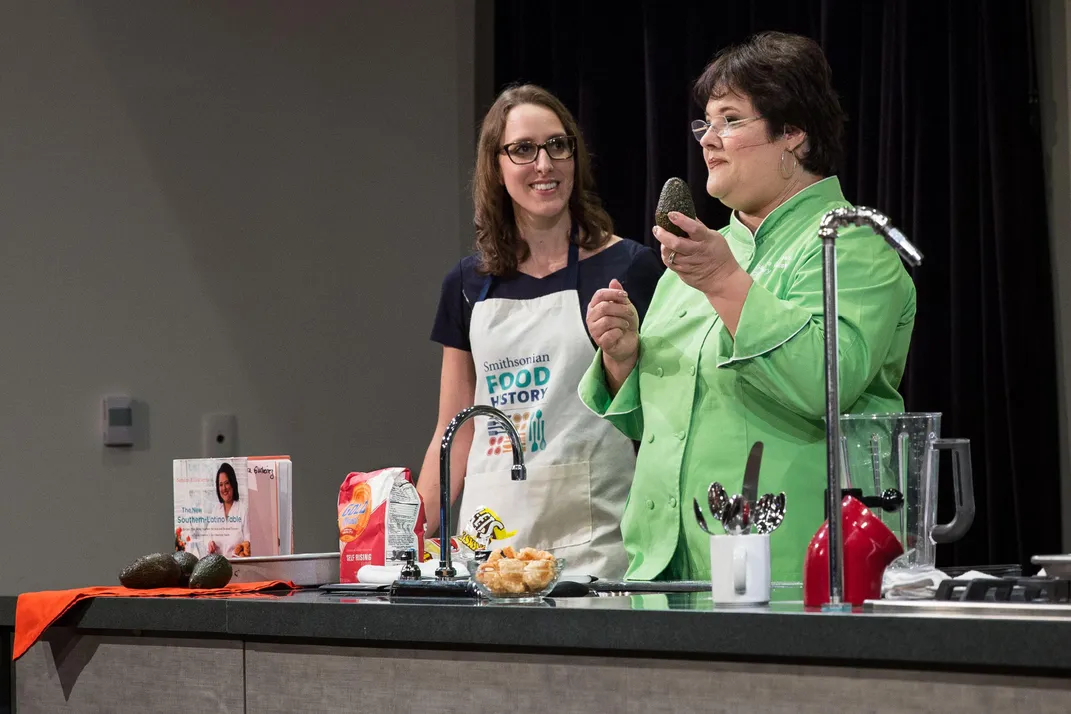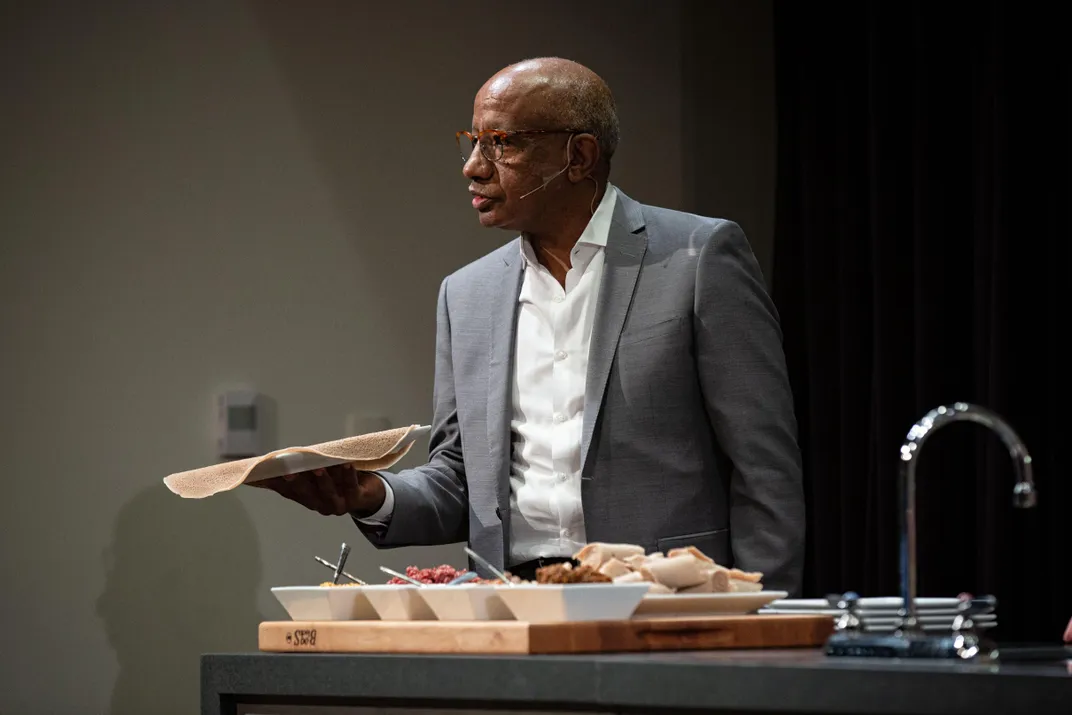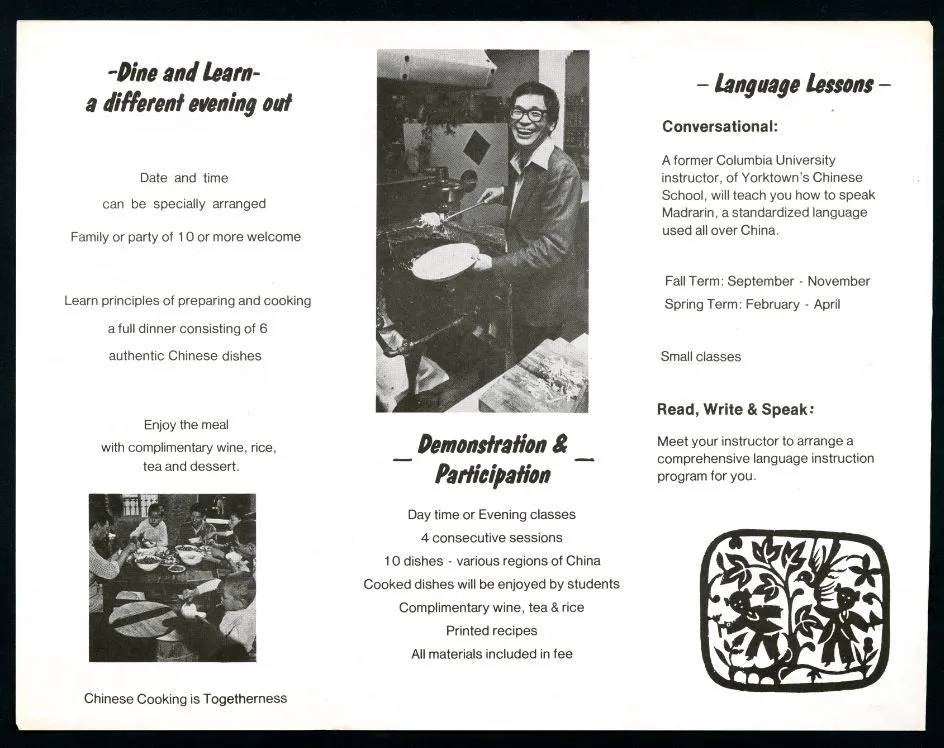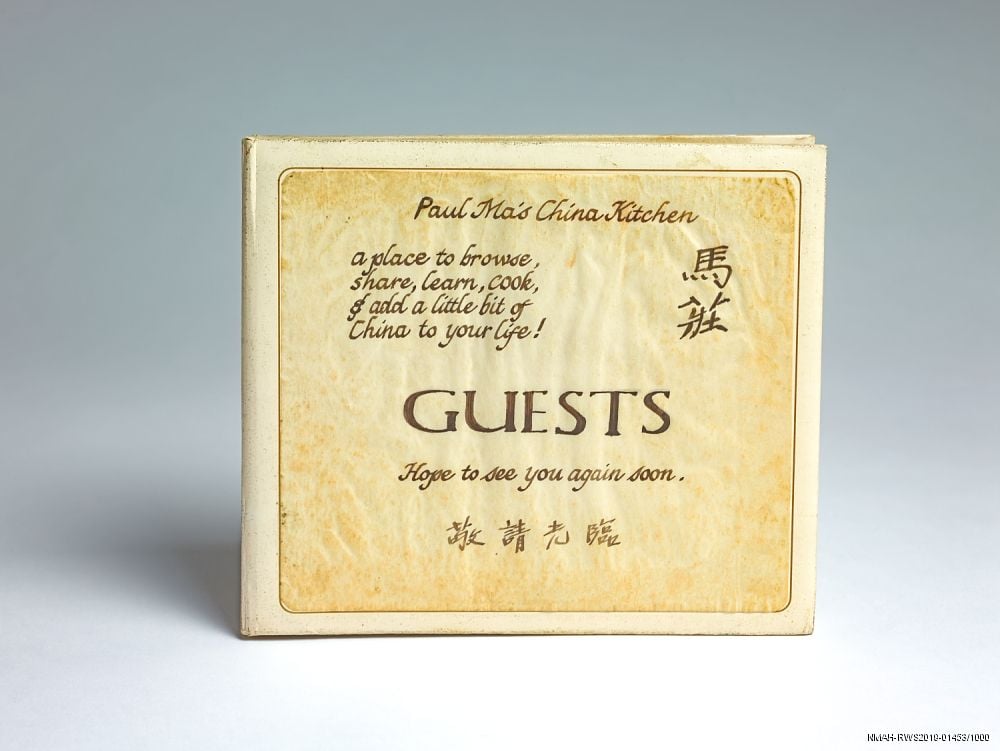How Food Brought Success to a Chef, a Cookbook Author and a Restaurateur
Historian Ashley Rose Young shares research from the Smithsonian’s 23-year-long ‘American Food History Project’
/https://tf-cmsv2-smithsonianmag-media.s3.amazonaws.com/filer/d1/25/d1252830-18c1-47d0-8a48-f0868c0ee085/istock-513124350.jpg)
Two men walked towards the demonstration kitchen stage, but only one looked the part of a chef. He was clad in a denim apron over a white shirt and khakis. His counterpart, bespectacled and wearing a suit and tie, strode onto the stage like a professor approaching a lecture podium, a map of China tucked under his arm.
What museum visitors that day may not have realized was that the professorial Paul Ma was about to resurrect his popular “Dine and Learn” class that he taught from the late 1970s to the 1980s at his upstate New York restaurant, Paul Ma’s China Kitchen. In the classes, guests enjoyed a live cooking demonstration that paired storytelling and lectures with a multi-course meal. His apron-clad assistant onstage at the Smithsonian’s National Museum of American History that day in October 2017 was none other than his nephew, the famed DC-area restaurateur and chef Tim Ma.
The yellowing map marked with grease stains and ink-like blotches of soy sauce was the same map that he used to guide eaters through the provincial cuisine of China during his original Dine and Learn classes. Just like a cookbook or a cleaver, this map was integral to Paul Ma’s China Kitchen and the educational experience he created for his guests. Later, he noted: “I combine good food with good stories. And the educational story. That’s why I carried my map all over.”
That day at the demonstration kitchen, Ma relied once again on his map to illustrate the regional variations in Chinese cuisine, but also to tell his own story of migration within China. Ma’s father was the chief arsenal engineer for Chiang Kai-Shek’s army, and so Ma’s childhood was marked by frequent moves throughout China, which also exposed Ma to the country’s vibrant and varied regional cuisines.
Ma sizzled with energy as he talked about the culture and politics of mid-Century China. Throughout the telling of his early life history, he discussed the food cultures of each region and how his cooking is a mosaic of these different local cuisines. He took those experiences of Chinese culinary traditions with him when he emigrated to the United States around 1970, and his mélange of Chinese cookery techniques became part of the story of American migration and food.
/https://tf-cmsv2-smithsonianmag-media.s3.amazonaws.com/filer/a1/1f/a11f8ea6-7af8-4c40-9599-425223040211/tim_ma_and_paul_ma.jpg)
Ma’s story and its place within the broader history of migration in the U.S. are examples of the cultural narratives studied by the Smithsonian’s American Food History Project. Migration has been a particular area of focus for the Project in recent years, especially during the current revamp of the exhibition, “FOOD: Transforming the American Table,” which examines the cultural and technological changes that shaped the ways people eat in the U.S. from 1950 to the present.
The Project seeks to understand the history of the U.S. through the multi-faceted lens of food. Food serves as a powerful window into the past because we interact with it on a daily basis, multiple times a day. What and how we eat expresses who we are as individuals, but also as members of a community. Food, though, stretches far beyond an individual’s personal experiences and ties into broader themes in American history related to capitalism, industrialization, technology, the environment, migration and more.
Later this month a new display “The Migrant’s Table,” debuts in the exhibition. The experience of migrant food entrepreneurs defines the American story. Food-related businesses and services like grocery stores, food trucks, restaurants and farms serve as an economic toehold for many new arrivals and have proven to be a path towards business ownership. According to the National Immigration Forum (NIF), immigrants are much more likely to start businesses than people born in the U.S. In 2015, immigrant-owned businesses, which made up 16 percent of businesses with paid employees in the U.S., generated $65.5 billion in income.
“The Migrant’s Table” focuses on the experiences of individuals who came to the U.S. after the landmark 1965 Immigration and Nationality Act, also known as the Hart-Celler Act, which eliminated previous immigration policies that largely discriminated against working class people from non-Western European countries.
According to the Power Research Center, the population of immigrants living in the U.S. quadrupled after 1965 and resulted in the resettlement of millions of people from parts of the globe that previously had far lower migration numbers to the U.S. Because of de facto discrimination, immigrants from areas like East Asia, Central and South America, the Caribbean, Africa and the Middle East had long been underrepresented. Like other migrants and refugees before them, they brought foods, flavors and ideas about what and how to eat, diversifying the palates of people living across the U.S.
In the exhibition, seven migrants from China, Guatemala, Ethiopia, Iraq, Pakistan, Morocco and Spain, who found new life as community leaders and entrepreneurs, tell stories of sharing food traditions with fellow migrants, but also with a broader, diverse American public. The display also showcases the stories of three second-generation Chinese Americans.
Two major themes emerged as Smithsonian researchers got to know these individuals on a more personal level. Meals—whether shared in the home, restaurants, street markets or prepared with ingredients from home or community gardens—are one of the most vital ways that migrant families maintain the tastes and traditions of their homelands. Meals are also an important way that migrants build connections and community with new neighbors in the U.S.
Researchers also found that food entrepreneurs saw their work not only as a way to stay connected to the traditions of their home countries, but also as an opportunity to share their food cultures and educate others. Of no surprise to anyone was that Paul Ma was a grocer and restaurant owner.
Ma always wanted to open a grocery store. When he first came to North America in 1964, though, he was in pursuit of a degree that would support his career as a medical statistician.
But while working as a statistician, he began offering Mandarin language lessons and cooking classes on the side. He found that he truly enjoyed teaching and building meaningful connections with students not only through language, but also through discussions about culture. His cooking classes grew increasingly popular, quickly filling up with students. He found a deep pleasure in creating a communal table where cultural exchange and education went hand-in-hand.
Ma hosted the popular classes near his specialty grocery store, a purveyor of Chinese products. Later on, he opened a restaurant downstairs to meet increasing customer demand. The store and restaurant were in Yorktown Heights, New York, about an hour north of Manhattan, and in close proximity to middle- and upper-class whites who desired to live close to, but not in the hustle and bustle of New York City.
The business was a family affair. Linda Ma, his wife and business partner, managed finances and helped to run the store and restaurant. Daughters, Pauline Ma-Hoffman and Eileen Ma, grew up in the store, as well as the restaurant that shared the same building. Like many children raised in family businesses, Ma-Hoffman’s childhood was marked by her parents’ daily schedule. “Once a month, we would get into the big station wagon, my sister, my parents, [to go] down to Chinatown. We’d bring back buckets of beansprouts,” she recalls.
The Mas went on to establish several other restaurants, including Shandong Inn and Shanghai Place, and also built another business leading culinary tours to China for American tourists. Immediate and extended family members, at one time or another, came to work at the Ma’s restaurants, which became “a center of the family,” according to Ma-Hoffman.
Of all of the Ma family businesses, the Dine and Learn class emerged as something separate and unique because of its attention to history, culture and community making. As Dine and Learn guests arrived—some having been on the waitlist for up to four years—they signed a guest book with a hand-drawn cover, with the words “Paul Ma’s China Kitchen. . . a place to browse, share, learn, cook, & add a little bit of China to your life!” For Ma, this education was not a one-way street. As expressed in a pamphlet advertising Ma’s classes, “Chinese Cooking is Togetherness.”

Cook and author Sandra Gutierrez is at heart a culinary educator. Gutierrez was born in the U.S. in Philadelphia, but raised in Guatemala, where she attended an American school that brought Guatemalan and U.S. cultural practices together.
Gutierrez’ life was not defined by two distinct cultures, but by a single culture that shared the traditions of Guatemala and the U.S. “Food at home was also a reflection of my fused reality: we ate tamales for special occasions. . . . and Carolina hot dogs every chance we got,” she explains in her cookbook, The New Southern Latino Table.
As an adult, Gutierrez and her husband, Louis Gutierrez, moved to the U.S., eventually settling in Durham, North Carolina. There in the American South, Gutierrez learned about Southern food traditions from her neighbors and in turn taught them about diverse Latin cuisines. It was while living in the South that she began to take note of the culinary movement that combines regional Southern and Latin American foodways and which now lies at the center of her culinary career. She notes in her cookbook that the regional cuisines of Latin America and the Southern United states share many ingredients and cooking techniques in common: ingredients like tomatoes, corn, pork, beans, sugar, potatoes and key techniques like barbecuing, braising, roasting and deep frying.
Culinary writing is one of the many ways Gutierrez builds interpersonal relationships. Inviting people into her family’s inner sanctum, she also hosts cooking classes in her home. In her kitchen, where ceramics from Guatemala share counter space with antique Jell-O molds found in Southern antique shops, Gutierrez shares her migration story and passion for food cultures.

Most nights, Sileshi Alifom can be found conversing with customers at his restaurant, DAS Ethiopian, in the Georgetown neighborhood of Washington, D.C., relying on his strong interpersonal skills to make meaningful connections.
Alifom and his wife, Elizabeth Wossen, opened DAS Ethiopian in 2011 after purchasing and rebranding an existing Ethiopian restaurant in the same location.
The restaurant’s look and feel is quite different from the city’s other Ethiopian establishments, which are often decorated with vibrant tapestries, woven baskets and other art from Ethiopia. Alifom drew upon his experience working 30 years for Marriot Hotels to create a striking interior décor fashioned after the international look: white tablecloths, cream colored walls, white plates and napkins, and black and white photographs. For his clients, Alifom has curated a playlist of international jazz music to complement the soothing ambiance.
Alifom and Wossen take seriously their role as cultural liaisons, considering themselves “cultural ambassadors.” For some of their restaurant clients the taste of tangy injera and richly aromatic chicken doro wat, the national dish of Ethiopia, might be the first. Alifom and Wossen want that experience to highlight the distinct spices, ingredients and flavor combinations of Ethiopian cuisine.
Both Alifom and Wossen were born in Ethiopia. Alifom emigrated when he was 17, and Wossen when she was three. Eventually, the two settled in Washington, D.C. where they pursued careers in the hospitality industry and diplomacy, respectively. A few years after Alifom migrated, Civil War broke out in Ethiopia, and thousands of Ethiopians came to Washington, D.C. The 1970s war-time immigration led to the areas around the city boasting some of the largest Ethiopian communities in the United States. As of 2017, U.S. Census Bureau data shows that around 5,000 Ethiopians are living in the District. Other sources like the Ethiopian Community Development Center, suggest that there may be up to 100,000 living in the greater D.C.-area.
Alifom notes the integral role of Ethiopian and Eritrean restaurants in D.C. in bringing the Ethiopian migrant community together. These were places “where people met, not necessarily for the food, but the food is what gravitated everybody to come.” These early restaurants were in D.C. neighborhoods like Adams Morgan and Shaw. As rents soared in the past few decades, however, many Ethiopian restaurants and specialty grocery stores have moved out to the suburbs including areas like Silver Spring, Maryland and Alexandria, Virginia.
/https://tf-cmsv2-smithsonianmag-media.s3.amazonaws.com/filer/2c/60/2c60aa82-3381-4cc8-9f05-363b381cebac/ethiopian_coffee_set.jpg)
Inspired by those early restaurants, Alifom seeks to create communal experiences among his own diners. In late spring and early fall, when temperatures linger at a pleasant 80 degrees or so, Alifom invites some patrons to return to the restaurant the following day for a special Ethiopian Coffee ceremony, a social ritual with deep roots in Ethiopian culture.
“The coffee is a place where I feel that a conversation begins. Whatever type of conversation. It could be social, it could be political for all you know, but the coffee is a setting that allows [for] that sort of conversation.”
Conversation made easier, Alifom suggests, as caffeine awakens the mind and encourages people to open up to one another and converse in a more vulnerable and meaningful way. The coffee ceremony is a catalyst for some people, he says, to “express thoughts, feelings, inner feelings in some cases.”
For Alifom, like Ma and Gutierrez, food and beverage are more than just a means of sustaining the body, but a means of sustaining the inner self and one’s community. One of the major takeaways of this research is that the process by which we feed our neighbors can also be the process by which we feed the soul.
The exhibition, “Food: Transforming the American Table” at the Smithsonian’s National Museum of American History in Washington, D.C. opens October 24, with new displays on migration and food, America’s brewing history, a history of diets and dieting, and the emergence of Mexican-American vintners.
The museum’s fifth annual Food History Weekend takes place November 7 to 9, 2019. On November 8 and 9, migrant food entrepreneurs, community activists and chefs will speak about their work and life experiences during “Deep-Dish Dialog” and “Cooking Up History” programs. Attendees can sample several of the dishes prepared on stage at the museum’s café, Eat at America’s Table.
/https://tf-cmsv2-smithsonianmag-media.s3.amazonaws.com/accounts/headshot/JN2019-00490-1.jpg)


/https://tf-cmsv2-smithsonianmag-media.s3.amazonaws.com/filer/8c/bd/8cbd39ae-d6ad-4937-9acb-dfb29328b2be/paul-pauline-and-eileen-macropped.jpg)
/https://tf-cmsv2-smithsonianmag-media.s3.amazonaws.com/accounts/headshot/JN2019-00490-1.jpg)